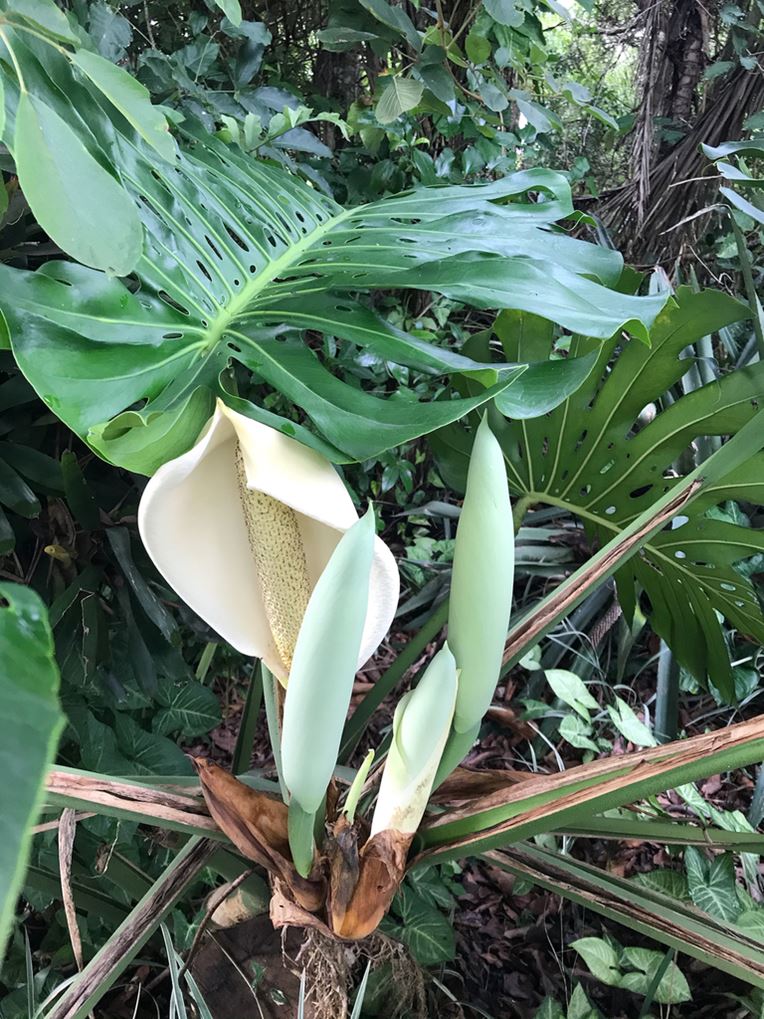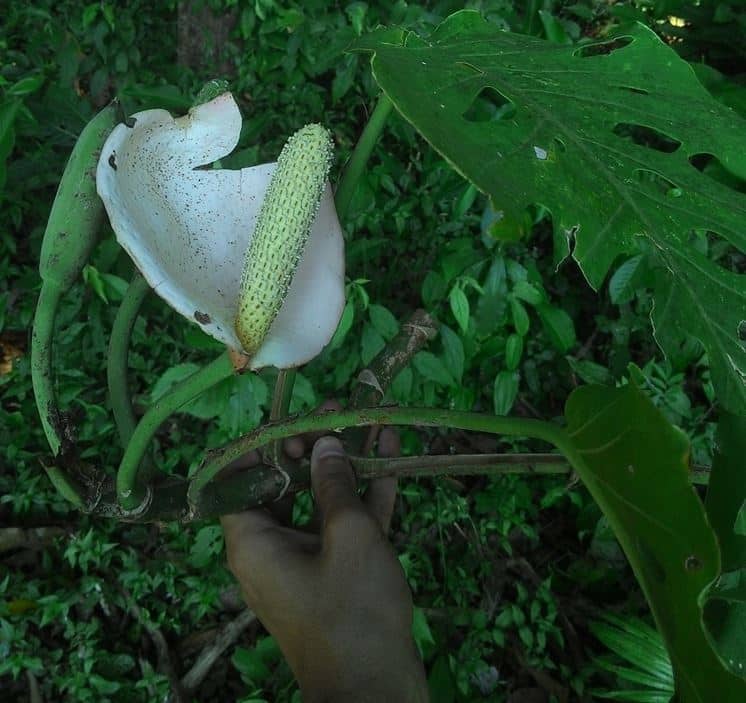Yes, it is not easy to see a Monstera flower in cultivation. But it doesn’t mean they don’t bloom completely. They have perfect inflorescent flowers borne on a spadix and surrounded by spadix.
Discover more about Monstera flowers, including blooming time and how they look. We will also talk about flowers for some popular species like Monstera deliciosa, adansonii, obliqua, siltepecana, among others.
Contents
About Monstera
Monstera comprises over 45 tropical rainforest plant species native to tropical America and surrounding islands. Some species make lovely plants thanks to the foliage or leaves that get larger, fenestrated, split, or both.
It grows as a hemiepiphyte, i.e., terrestrial plants at one stage and epiphytes (other plants) on another.
Monstera has three growth stages, i.e., the baby or seedling, juvenile or adult, or mature stage. Only when it matures will it begin flowering and fruiting.

About Monstera flower
When blooming, the primary shoots (sympodium) will bear two cataphylls, and an erect spadix surrounded by a spathe (leaf-like bract), except M. tuberculate will have pendent spadices.
Most Monstera species will produce a cluster of 2 to 4 spadices. But Monstera obliqua may have up to 8 spadices clusters, and Monstera lechleriana will have only one.
The flower stalk or peduncle is 2 to 18 inches long, flatted, or terete, with thickness varying from 5/64 to ⅛ inches.
When emerging, it has a green spathe wrapping the spadix. But when the spathe unfurls, the boat-shaped or hemispherical spathe will turn white, deep yellow to rose, depending on the species you have. After it has opened, it will persist for about 2 to 3 days and fall unless tangled.
On the other hand, the spadix is green or white in the bud stage, and it changes to white or yellow when the flower opens. Afterward, it will turn green and remain green to fruit maturity or turn yellowish, white, or orange. Also, its size will double (length and width).
The spadix has the inflorescence flowers arranged in a spiral manner with those at the base sterile.
Flower pollination is by beetles, bees, and some flies, and to prevent cross-pollination, the female flower part matures early by a day or two. Also, you should know that the flowers mature upward starting from the base.
During the anthesis (when the flower opens), the spadix may increase the temperature with Monstera deliciosa noted to increase by 59°F (15°C).
Last but not least, Monstera fruits will mature after 2 to 15 months, depending on the species you have. The fruits have tiny oblong seeds and inedible pulp except for Monstera deliciosa or Swiss-cheese plant fruits. But ensure they ripe fully before eating them.
When do Monstera bloom?
In the wild, Monstera has no specific blooming time or season. Instead, they will flower during any month long as the plant matures. Under cultivation, these plants don’t usually bloom.
Should it flower in temperature regions, you will most likely see the blooms in summer after an active growing winter season. But as already said, there is no specific blooming time.
Flowers of some Monstera species
Are you curious to know a little more about some of the Monstera species fruits? Here are a few and their appearance.
1. Monstera deliciosa flower
The lovely, heart-shaped deep green leaves that get split and fenestrated makes Monstera deliciosa one of the most popular houseplants in America.
Did you know it is purifying? What’s more, the fruits are edible. But you will have to wait for 12 to 14 months before they mature.

How about the flowers? It has a white/cream to yellowish spathe and a white to green flowering spadix. The fruiting spadix is bluish-green or green. But since it has varieties, these colors vary, i.e., var. sierrana, var. borsigiana, var Brazil, etc., will have different colors. Don’t be surprised if you see a slightly different description.
2. Monstera adansonii flower
Also known as the Swiss Cheese plant or Monkey Mask Monstera, Monstera deliciosa takes pride in the lovely leaves with holes but an entire margin. It doesn’t have splits.
There is a narrow and wide form and varieties like var. laniata. You will also get variegated forms.
This species has a cream to pale yellow spathe while the spadix is cream to yellow. The fruiting spadix will be green, and on maturing, it will turn to deep yellow.

3. Monstera obliqua flower
Monstera obliqua is a rare, unique, and costly species mainly in the domain of rare plant collectors. It has holes covering most of the leaf surface and an entire margin. We bet you will love it. It is terrific.
What about the Monstera obliqua flower? It has a deep yellow flowering spadix that turns green or olive green with some orange tinge in the fruiting stage. At maturity, it will be deep orange.
Note: All images are copyrighted. If you still want to see how it looks like, visit Inaturalist.org.
The spathe is bright yellow when the flower matures and green to white while the flower is young.
4. Monstera siltepecana
Monstera siltepecana is a high-altitude species with entire bluish-green juvenile leaves with dark green veins and a silvery sheen. When it matures, the leaves turn deep or dark green and get only holes. No splits. The number of holes, arrangement series, leaf size, and shape vary much.
The flowering spadix is white and has a rose-red spathe on the inner side and greenish-white on the outer surface.

Fruits are deep green, and you can quickly identify this species because its stalk is longer or equal to the spadix, just as the M. subpinnata.
5. Monstera dubia
If you love shingling houseplants such as Rhaphidophora hayi or cryptantha, we bet you will love Monstera dubia. It has heart-shaped, dark green leaves with silvery variegations or sheen that lie flat on the surface they are climbing on or shingle.
Mature leaves dramatically become large, dull dark green, and will have start having splits and holes.

What about flowers? They have a white flowering spadix, a rose to salmon spathe on the outer side and a white inside. The fruiting is pale yellow, and when ripe, you will see oblong seeds embedded on the gray pulp.
6. Monstera lechleriana
Monstera lechleriana is the slowest growing of all the species. It has glossy green juvenile leaves borne on a tight head or cluster. When leaves mature, they will have elliptical holes close to the rib margin and an entire margin (no splits).
Monstera lechleriana will flower after 6 to 8 years in its natural habitat and will have cream to pale inflorescent flower and a white to pale yellow spathe. See M. lechleriana flower.
The fruiting spadix is cream to yellow, and the berry-like fruits will have brown, oblong seeds.
7. Monstera standleyana
Monstera standleyana has elliptical to oval, glossy, deep green juvenile leaves that are not symmetrical. But there are variegate forms, i.e., Albo and Aurea.
When it matures, it will have large leaves that remain entire. But a few may get holes.
Flowers are yellow to white, and their spathe is cream to whitish.
8. More species
We didn’t look at all the Monstera species grown as houseplants. Here are others that we have covered elsewhere.





Leave a Reply